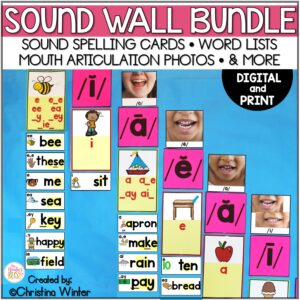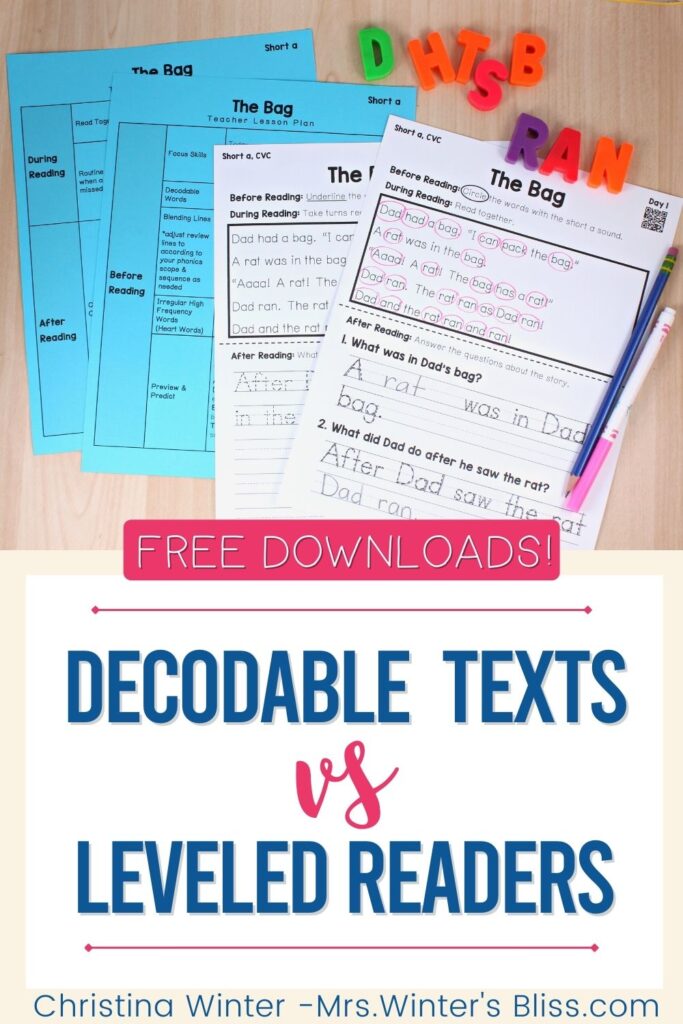

In this post, I discuss the difference between decodable texts and early leveled readers. I explain when students should move from decodable to leveled texts and share information about my decodable passages and decodable books with comprehension questions Finally, I leave you with FREE decodable passages and 5 FREE decodable books you can use for small group instruction or literacy centers in kindergarten, first and second-grade classrooms.
Recently, there has been discussion over whether beginning readers should use decodable texts or leveled readers. The science of reading has found that in order for comprehension to improve, a student’s ability to decode must increase. A powerful way to improve a student’s decoding skills is through the use of decodable texts. So what role do leveled books now play? We used them for years, but is it now time to toss them out?
No!! The truth is that leveled AND decodable texts BOTH have a place classroom. They just serve different purposes. When used properly they are a powerful combination to help build students’ reading skills.
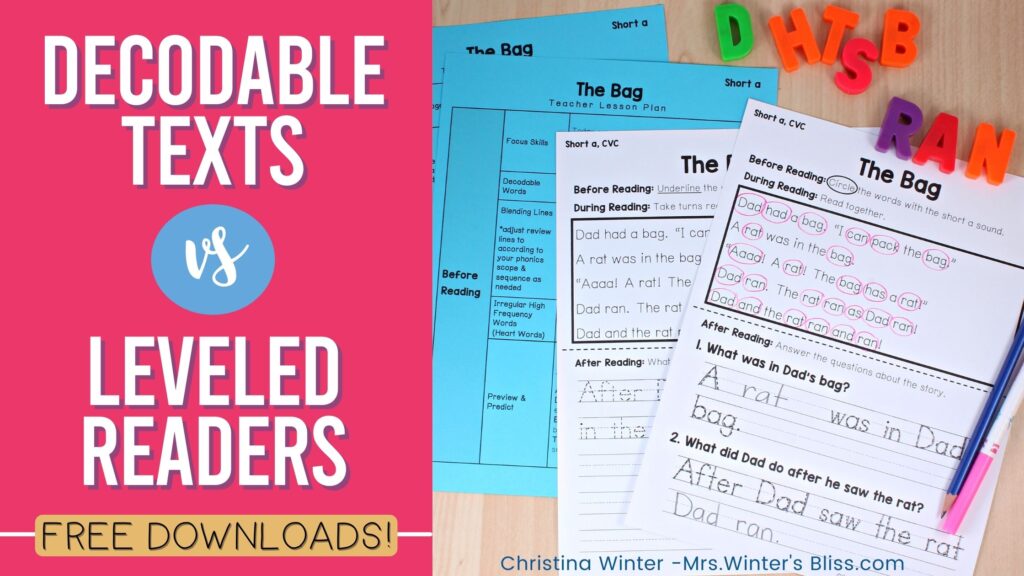
Today I’m excited to share what I’ve learned through the webinar, Using Decodable and Leveled Readers Appropriately, further research, and in Wiley Blevins’ book, Choosing and Using Decodable Texts. I’ll discuss the differences between decodable texts and early leveled readers, and explain when students should move from decodable to leveled texts. Finally, I’ll leave you with information about my decodable passages with comprehension questions resource that you can use for small group instruction or in your literacy centers.
What is a Decodable Text?
A decodable text is a text you use in beginning reading instruction. It can be a book, a passage, or a poem that only includes phonics patterns and high-frequency words that you have already taught your students.
The focus is on developing accurate decoding. There may be some focus on literal comprehension, but the main emphasis is on accuracy and decoding. A decodable text or passage may include pictures. If it does, the picture supports the story, but not specific words in the text.
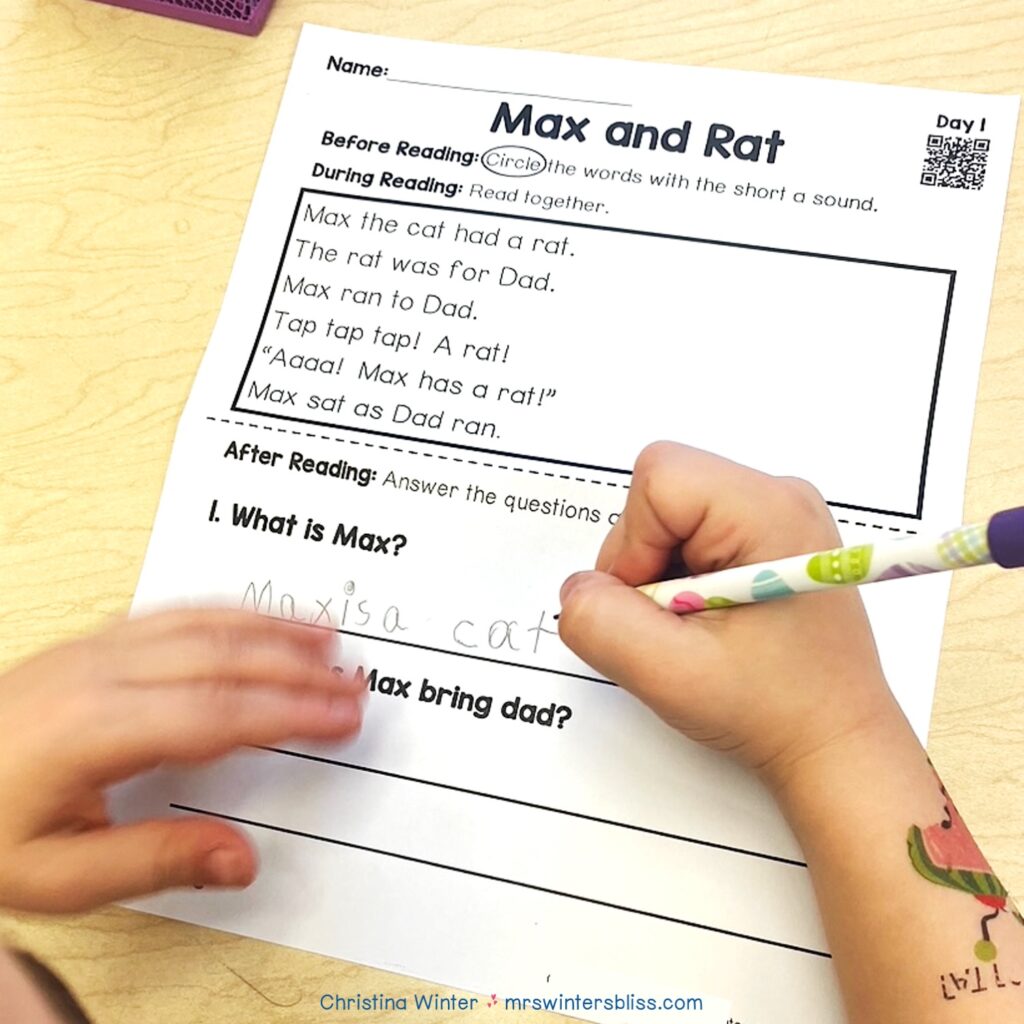
Decodable texts give students practice applying the skills they have learned to real reading experiences. Children progress at a much faster rate when the majority of time is spent applying skills to authentic reading.
When Should You Use Decodable Texts?
Decodable texts give students practice with the phonics skills you have taught. It is best to use them directly after a decoding lesson where students have received explicit instruction on a specific phonics skill. This gives them the opportunity to see what they are learning as a real application. Application is how the skills stick!

You can use decodable texts for small group instruction or as a literacy center to give students more independent practice. Curious to learn more about specific instructional routines for decodable texts? Grab a drink and take some time to watch this video where I share specific tips and information for choosing and using decodable texts.
What is a Leveled Reader?
Books that are categorized into levels of difficulty are referred to as leveled readers. Early leveled readers are often predictable and about familiar topics that students can discuss. They include a lot of high-frequency words, repeat words often, and have pictures that provide a lot of text support.
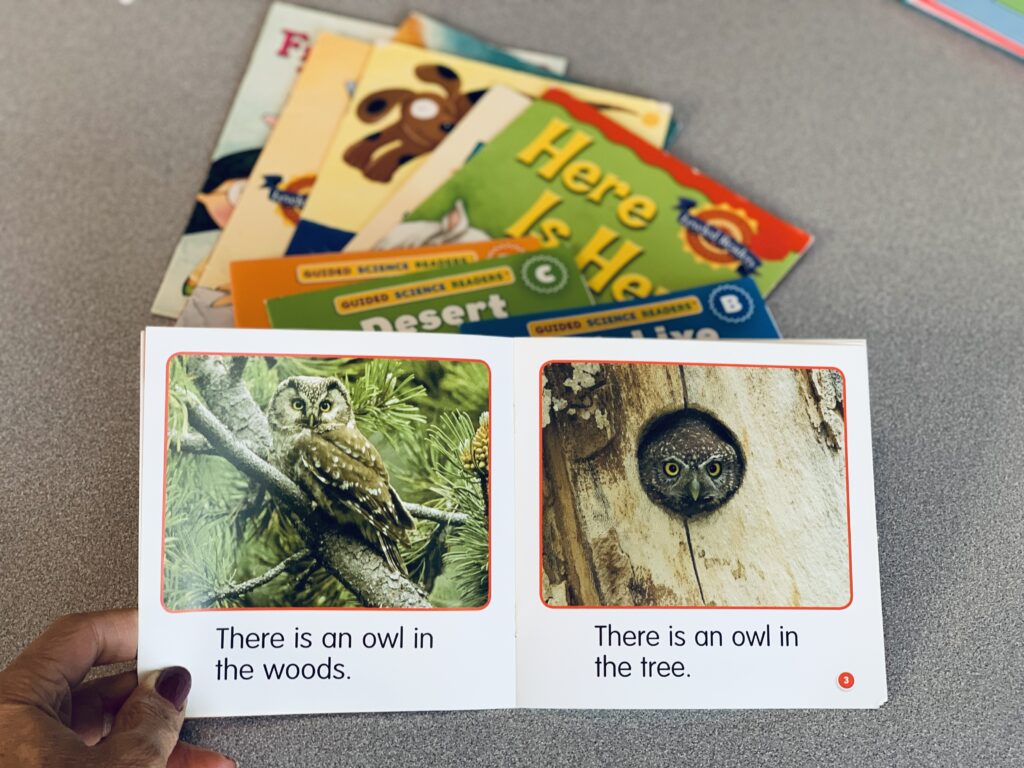
Beginning leveled readers are not based on phonics skills students have learned. Instead, the reading level is determined by the number of words in the entire reader and the length of the words. The shorter the sentence and the shorter the words, the lower the level.
The premise of leveled readers is that students learn to read words through exposure, not through direct instruction (though we now know this is NOT true). When students encounter an unknown word, they are first encouraged to use the pictures and context to guess the word. If that doesn’t work then they examine the letters in the word. Leveled texts focus on meaning and comprehension more than accuracy.
When Should You Use Leveled Readers?
Leveled readers are great for oral language development because they focus on comprehension and meaning more than accuracy. They can make wonderful read alouds, allow for vocabulary development, and lead to great class discussions.
Leveled readers can also teach students concepts of print. Use them to show students where to find the title, author and illustrator. Students can see how words are spaced, sentences begin with a capital letter and end with punctuation, and how text moves from top to bottom and left to right.
When Should Students Move from Decodables to Leveled Readers?
Decodables are a tool used to teach decoding. After students show strong decoding skills, they are ready to read leveled books independently. According to Linda Farrell and Michael Hunter of readsters.com, students should continue to use decodable readers until they can do ALL three of these things:
- Demonstrate mastery of decoding real and nonsense CVC words (short vowels, digraphs, and blends) in isolation.
- Decode 2-syllable words and known 3-syllable words in isolation that have short vowel syllables (closed) or schwa.
- Decode one and 2-syllable real words with r-controlled vowels and silent e.
Generally, students are able to do these three things towards the end of first grade or the beginning of 2nd grade.
A No Prep Decodable Texts with Comprehension Questions
If you have students who are just beginning to learn to read they definitely need decoding instruction! We now know decodable texts are the best way to help these students.
Wondering how and where to begin? Let me help you! These Decodable Passages with Comprehension Questions and my Decodable Book with Comprehension Questions have all you need to give your students a strong foundation in early reading!
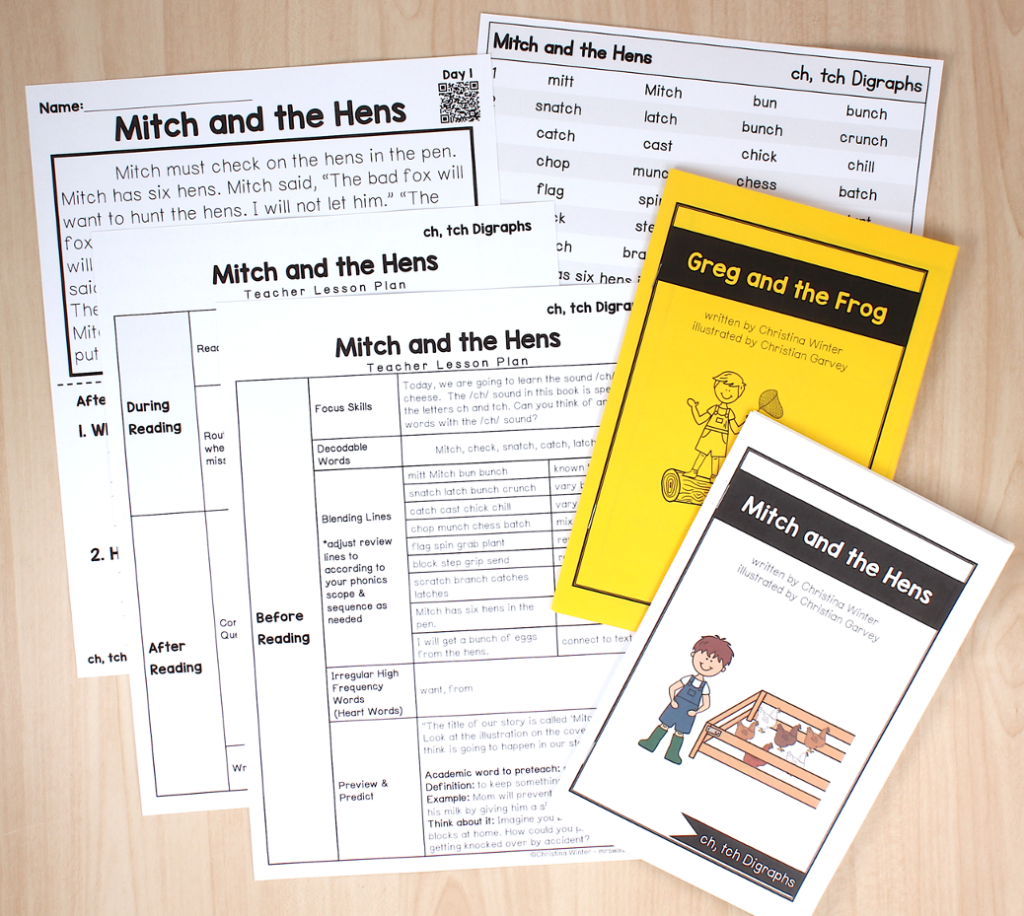
Both of these resources align with a research-based, systematic phonics scope and sequence (included). While they focus on the same skills, the texts in the two resources are NOT the same.
Included with each passage and book:
💗 explicit lesson plans with suggested pacing
💗 activities for before, during, and after reading
💗 blending lines to practice skills and frontload before reading
💗 written and oral comprehension response questions specific to the passage
💗 audio recording for those students who may need extra support
💗 write and retell story response questions
💗 printable passages give students the opportunity to re-read and build fluency
These decodable texts are phonics-based texts. They contain target phonics skill words, previously taught phonics skill words, and irregular high-frequency words.
Are you ready to begin using decodable texts in your classroom? To help get you started, I’m happy to share this FREE sample that includes 5 decodable passages and these 5 FREE decodable books! You’ll get explicit lesson plans for each passage and book, along with activities for before, during, and after reading to strengthen phonics skills!
-
Sale Product on sale
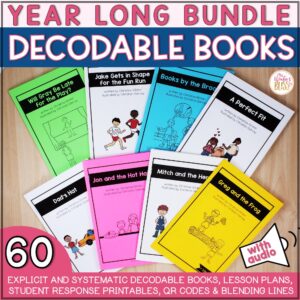 Decodable Books BUNDLE – Comprehension Questions aligned to Science of ReadingEarn 0 Reward Points
Decodable Books BUNDLE – Comprehension Questions aligned to Science of ReadingEarn 0 Reward Points$60.00Original price was: $60.00.$48.00Current price is: $48.00.Rated 5.00 out of 5 based on 6 customer ratings -
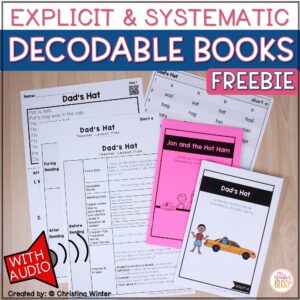 FREE Decodable Books with Comprehension Questions$0.00Rated 4.96 out of 5 based on 24 customer ratings
FREE Decodable Books with Comprehension Questions$0.00Rated 4.96 out of 5 based on 24 customer ratings -
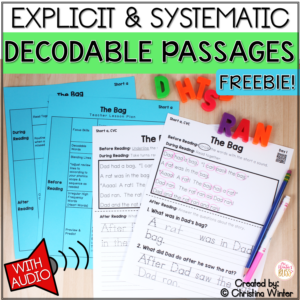 FREE Decodable Passages with Comprehension Questions$0.00Rated 4.98 out of 5 based on 40 customer ratings
FREE Decodable Passages with Comprehension Questions$0.00Rated 4.98 out of 5 based on 40 customer ratings -
Sale Product on sale
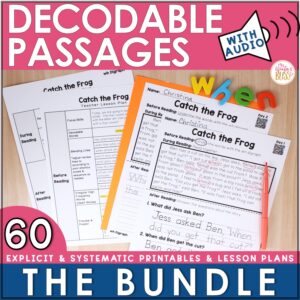 Decodable Passages with Comprehension Questions – BundleEarn 0 Reward Points
Decodable Passages with Comprehension Questions – BundleEarn 0 Reward Points$38.25Original price was: $38.25.$30.60Current price is: $30.60.Rated 5.00 out of 5 based on 11 customer ratings
I hope the information I have shared today helps you to better understand when and why to use decodable and leveled texts with your students and bring more effective early reading instruction to your classroom!










